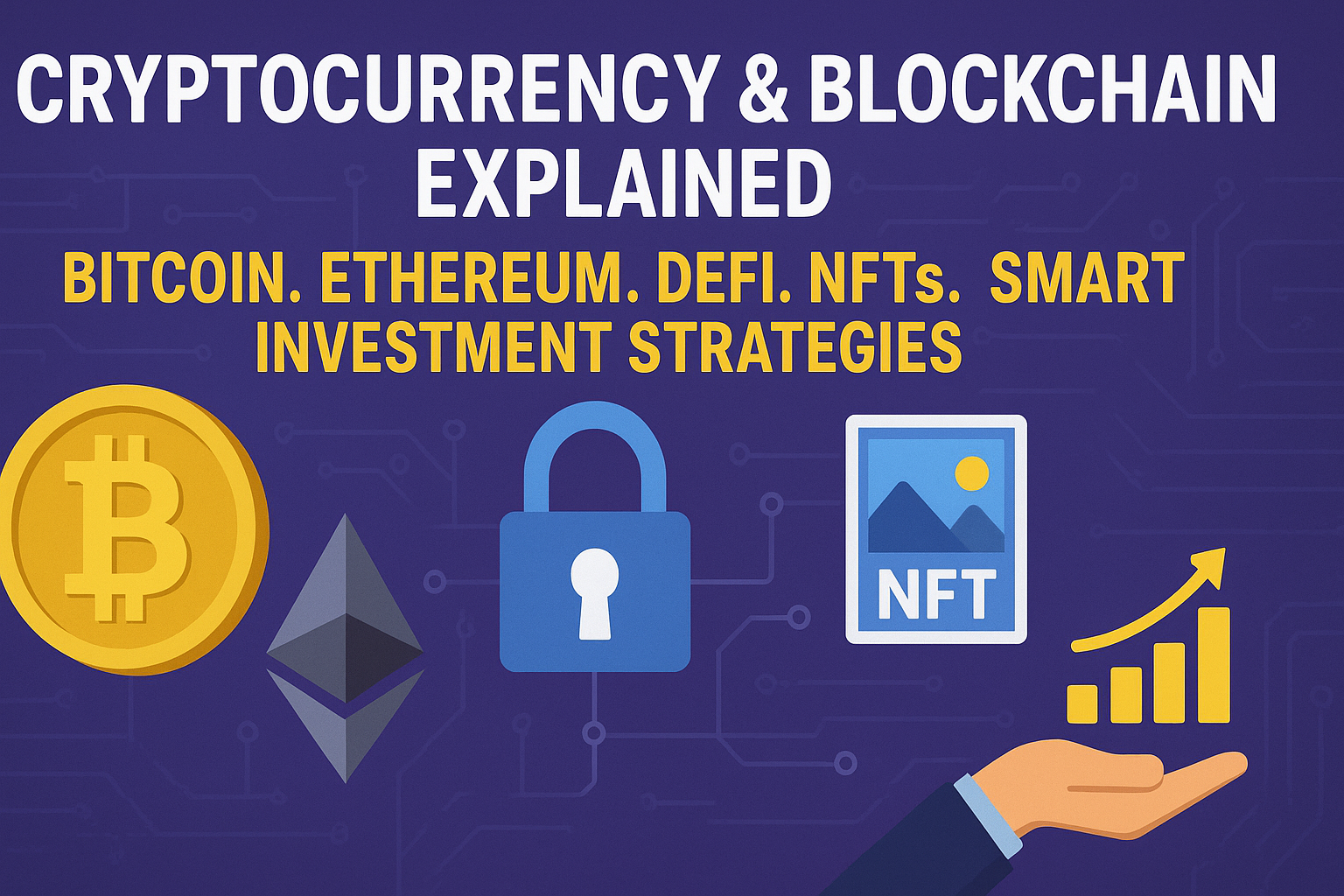Over the past decade, cryptocurrency and blockchain technology have transformed the global financial landscape. What started with Bitcoin in 2009 has now grown into a trillion-dollar industry, offering not just digital currencies but also smart contracts, decentralized finance (DeFi), and non-fungible tokens (NFTs).
For beginners and investors alike, understanding how cryptocurrencies work and how to invest safely is crucial. This article breaks down the fundamentals of Bitcoin, Ethereum, DeFi, NFTs, and explores smart crypto investment strategies for the future.
What Is Cryptocurrency and Blockchain?
- Cryptocurrency is a digital or virtual currency secured by cryptography, making it almost impossible to counterfeit. Unlike traditional money, cryptocurrencies are decentralized and not controlled by any government or central bank.
- Blockchain is the underlying technology that powers cryptocurrencies. It is a distributed ledger system that records all transactions in a transparent, secure, and tamper-proof manner.
- In simple terms, blockchain is the “engine,” while cryptocurrencies are the “cars” running on it.
Bitcoin – The First Cryptocurrency
Bitcoin (BTC), created by an unknown person or group under the name Satoshi Nakamoto in 2009, was the world’s first cryptocurrency. It introduced the concept of decentralized digital money.
- Maximum Supply: 21 million coins (limited, making it scarce).
- Use Cases: Digital payments, hedge against inflation.
- Price History: From few cents in 2010, Bitcoin reached an all-time high of over $68,000 in 2021.
- Many investors view Bitcoin as “digital gold” due to its limited and supply
Ethereum – Beyond Digital Currency
- While Bitcoin is mainly seen as digital money, Ethereum (ETH), launched in 2015, expanded the use of blockchain. It introduced smart contracts, which are self-executing agreements without intermediaries.
- Smart Contracts: Allow developers to build decentralized applications
- Ethereum Network: Powers most of the DeFi and NFT projects.
- Utility: Used for payments, staking, decentralized finance, and token creation.
- Ethereum remains the backbone of blockchain innovation.
DeFi – Decentralized Finance Revolution
- Decentralized Finance (DeFi) refers to financial services like lending, borrowing, and trading built on blockchain, without banks or intermediaries.
- Examples: Aave, Compound, Uniswap.
- Benefits: Lower fees, global access, transparency.
- Risks: Smart contract bugs, high volatility, and regulatory concerns.
- DeFi is considered one of the fastest-growing sectors in the crypto world, offering users more control over their money.
NFTs – Digital Ownership on Blockchain
- Non-Fungible Tokens (NFTs) are unique digital assets representing ownership of items like art, music, videos, or even virtual real estate.
- Bitcoin or Ethereum each NFT is one of a kind.
- Use Cases: Digital art, gaming assets, collectibles, metaverse property.
- Boom Period: In 2021, NFTs gained global attention with multi-million-dollar digital art sales.
- Though NFT prices have become more stable, the technology continues to evolve, with potential in entertainment, gaming, and identity verification.
Smart Cryptocurrency Investment Strategies
Investing in cryptocurrency can be profitable, but it also carries risks due to volatility. Here are some smart crypto investment strategies for beginners:
1. Diversify Your Portfolio
Don’t put all your money in Bitcoin. Add Ethereum, stablecoins, and a few promising altcoins.
2. Use SIPs in Crypto
Just like mutual funds, invest small amounts regularly instead of lump sums. This reduces the impact of volatility.
3. Hold for the Long Term (HODL)
Short-term trading is risky. Long-term holding has historically given higher returns in Bitcoin and Ethereum.
4. Secure Your Assets
Always use hardware wallets or trusted exchanges with strong security.
5. Stay Updated
Follow news, regulations, and market trends. Crypto markets change rapidly, so knowledge is power.
Risks in Crypto Investments
- While cryptocurrencies can offer high returns, investors must be cautious about risks:
- Market Volatility: Prices can rise or crash within hours.
- Regulatory Uncertainty: Different countries have different stances on crypto.
- Security Risks: Hacking, scams, and phishing attacks are common.
- Lack of Awareness: Many beginners lose money due to poor knowledge.
- Invest only what you can afford and always research before investing.
The Future of Cryptocurrency and Blockchain
- Experts believe blockchain and cryptocurrencies will continue to reshape industries. Some future trends include:
- Central Bank Digital Currencies (CBDCs).
- Wider adoption of blockchain in healthcare, supply chain, and identity management.
- Growth of Web3 and the metaverse powered by NFTs and DeFi.
- Increased regulation to protect investors.
- While uncertain, the future of cryptocurrency and blockchain looks promising, with endless innovation potential.
Conclusion
The world of cryptocurrency has evolved far beyond digital money. From Bitcoin as a store of value to Ethereum’s smart contracts, and from DeFi financial systems to NFTs revolutionizing digital ownership, blockchain is changing how we view finance and technology.
Also Read : Ration Card New Rules 2025 लागू – क्या आपको भी मिलेगा मुफ्त राशन? अभी चेक करें
For investors, the key lies in understanding risks, diversifying portfolios, and adopting disciplined strategies like SIPs and long-term holding
Cryptocurrency is not a get-rich-quick scheme, but a long-term opportunity for those willing to learn, adapt, and invest wisely. The sooner you start educating yourself, the better prepared you’ll be for the financial systems of tomorrow






